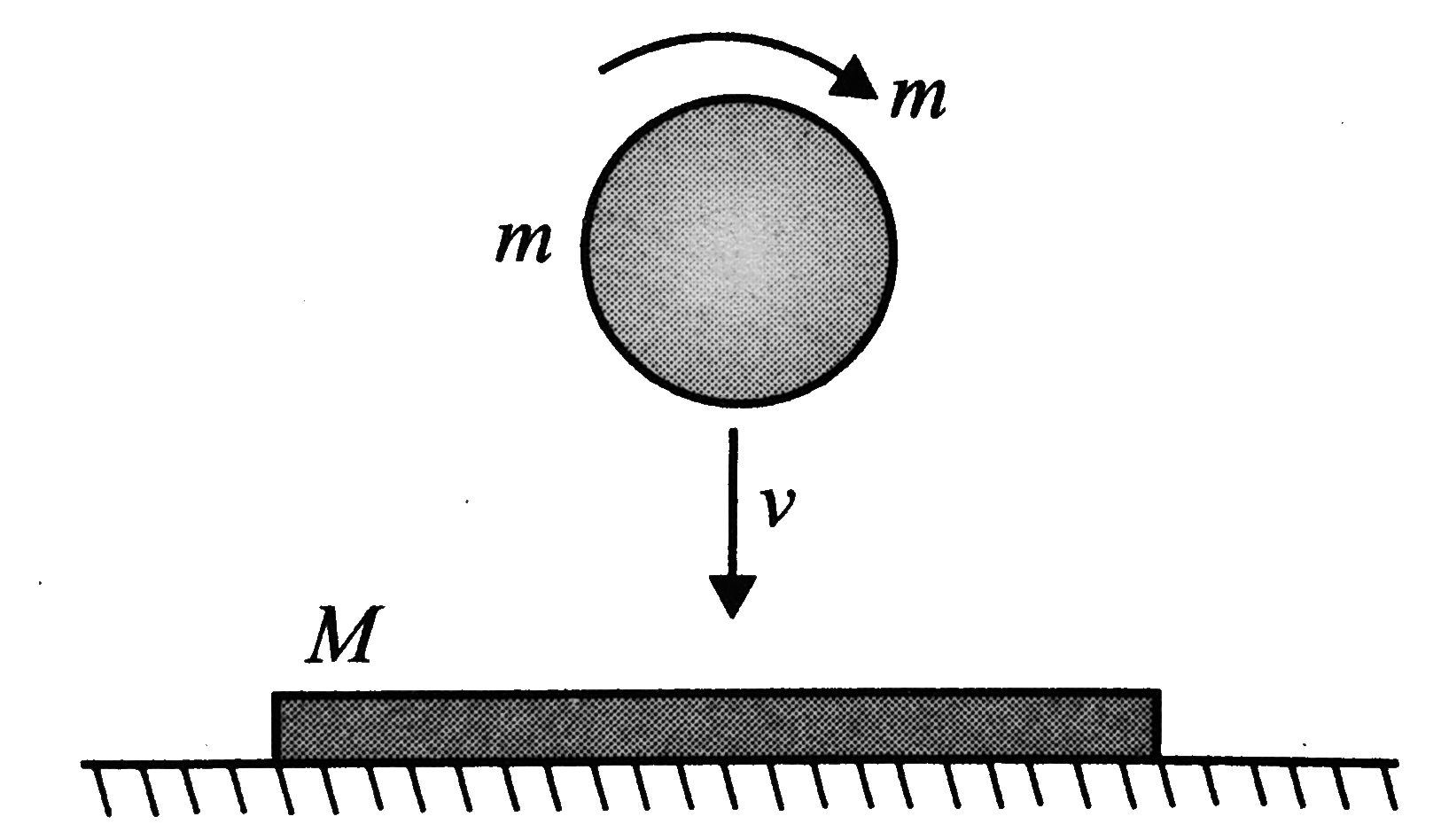A ball is given a velocity v and angular velocity such that the ball rolls purely on a plank whose upper surface is rough enough to prevent slipping but lower surface contact with the ground is smooth. No other force is acting on system.
The plank will recoil back.
The plank will also move forward but with a lesser velocity than that of the ball.
The plank will also move forward but with a lesser velocity than that of the ball.
The plank will remain at rest.
The correct Answer is:D
Since vpoint of contact=0, no friction acts between ball and plank
No impulse acts on plank or ball.

Topper's Solved these Questions
- RIGID BODY DYNAMICS 2Book:CENGAGE PHYSICSChapter:RIGID BODY DYNAMICS 2Exercise:Multiple Correct
Explore 26 Videos
- RIGID BODY DYNAMICS 2Book:CENGAGE PHYSICSChapter:RIGID BODY DYNAMICS 2Exercise:Linked Comprehension
Explore 71 Videos
- RIGID BODY DYNAMICS 2Book:CENGAGE PHYSICSChapter:RIGID BODY DYNAMICS 2Exercise:Subjective
Explore 19 Videos
- RIGID BODY DYNAMICS 1Book:CENGAGE PHYSICSChapter:RIGID BODY DYNAMICS 1Exercise:Integer
Explore 11 Videos
- SOUND WAVES AND DOPPLER EFFECTBook:CENGAGE PHYSICSChapter:SOUND WAVES AND DOPPLER EFFECTExercise:Integer
Explore 16 Videos
Similar Questions
In the figure the plank resting on two cylinders is horizontal. The plank is pulled to the right such that the centre of smaller cylinder moves with a constant velocity v. Friction is large enough to prevent slipping at all surfaces. Find-
(a) The velocity of the centre of larger cylinder.
(b) The ratio of accelerations of the points of contact of the two cylinders with the plank.

View SolutionDuring rolling without slipping, what is the velocity of the point in contact with the surface.
View Solution
Knowledge Check
A cylinder executes pure rolling without slipping with a constant velocity on a plank, whose upper surface is rough enough, but lower surface is smooth. The plank is kept at rest on a smooth horizontal surface by the application of an external force F. Choose the correct alternative:
 AThe direction of F is towards right.BThe direction of F towards left.CThe value of F is zeroDThe direction of F depends on the ratio of the relative masses of disc and plank.
AThe direction of F is towards right.BThe direction of F towards left.CThe value of F is zeroDThe direction of F depends on the ratio of the relative masses of disc and plank.A sphere S rolls without slipping moving with a constant speed on a plank P. The friction between the upper surface of P and the sphere is sufficient to prevent slipping, while the lower surface of P is smooth and rest on the ground. Initially P is fixed on the ground by a pin N. If N is suddenly removed
 AS will begin to slip on PBP will begin to move backwardsCThe speed of S will decrease and its angular velocity with increaseDThere will be no change in the motion of S and P will still be in rest
AS will begin to slip on PBP will begin to move backwardsCThe speed of S will decrease and its angular velocity with increaseDThere will be no change in the motion of S and P will still be in restA solid sphere with a velocity (of centre of mass) v and angular velocity ω is gently placed on a rough horizontal surface. The frictional force on the sphere :
Amust be forward (in direction of v)Bmust be backward (opposite to v)Ccannot be zeroDnone of the above
.A ball is projected upwards from a height h above the surface of the earth with velocity v .The time at which the ball strikes the ground is
View SolutionA solid ball of mass m and radius R spinning with angular velocity ω falls on a horizontal slab of mass M with rough upper surface (coefficient of friction μ ) and smooth lower surface. Immediately after collision, the normal component of velocity of the ball becomes half of its value just before collision and it stops spinning. Find the velocity of the sphere in horizontal direction immediately after the impact (given :Rω=5 ).

View SolutionA solid ball of mass m and radius r spinning with angular velocity ω falls on a horizontal slab of mass M with rough upper surface (coefficient of friction μ) and smooth lower surface. Immediately after collision the normal component of velocity of the ball remains half of its value just before collision and it stops spinning. Find the velocity (in m/s) of the sphere in horizontal direction immediately after the impact (given: Rω=5).

View Solution
A board is moving with velocity v on a smoother horizontal plane. The upper surface of the board is rough on which a ball falls with velocity v and rebounds with velocity v2. The mass of the board is same as that of ball. After the collision, the board comes to state of rest. The co-efficient of friction between the board and the ball is
View SolutionA ball is projected upwards from a height h above the surface of the earth with velocity v. The time at which the ball strikes the ground is
View Solution

